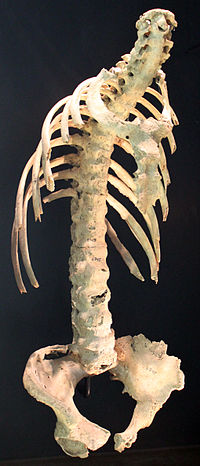
Photo from wikipedia
PURPOSE The aim of this study was to describe the epidemiological profile of uveitis cases treated at University Hospital Clementino Fraga Filho and to identify the presentation pattern of intraocular… Click to show full abstract
PURPOSE The aim of this study was to describe the epidemiological profile of uveitis cases treated at University Hospital Clementino Fraga Filho and to identify the presentation pattern of intraocular inflammation on the basis of clinical, anatomical, etiological, and demographic criteria. METHODS A retrospective study was conducted using data from the medical records of 408 patients with active disease who attended the ophthalmology service between March and October 2018. Age, sex, visual acuity at the time of diagnosis, anatomical and etiological diagnoses, the clinical aspect, and the main symptoms reported during anamnesis were described. RESULTS Of the 408 patients in the study, 52% were male and 48% were female. The patients' mean age was 42 years, and most (84%) were between 19 and 64 years old. Anterior uveitis was observed in 37.75% of the patients; posterior uveitis, in 49.75%; panuveitis, in 4.66%; and intermediate uveitis, in 3.43%. Only 18 patients (4.41%) presented with scleritis. Of the 390 patients with anatomical classifications, 76% had known etiologies, with the most prevalent diagnoses being toxoplasmosis (35.4%), followed by juvenile idiopathic arthritis (6.4%), ankylosing spondylitis (5.9%), and syphilis (4.9%). Infectious uveitis corresponded to 49.7% of the patients, while 26.6% of the cases were of noninfectious origin. Anterior uveitis had the highest number of cases classified as idiopathic (49.4%). In the cases of posterior uveitis, the etiology was established 94% of the time. The most frequent symptoms were ocular pain (71.8%) and blurring vision (56.8%). CONCLUSIONS The present study confirmed the historical importance of infectious uveitis in our population, especially ocular toxoplasmosis. Uveitis appears to have no predilection for sex but mainly affects young people of working age, thus generating social and economic consequences. Despite the evolution of diagnostic methods, idiopathic uveitis remains one of the major etiologies. Epidemiological studies point to different presentation patterns of uveitis in different populations, but these may reflect the distinct characteristics of each institution.
Journal Title: Arquivos brasileiros de oftalmologia
Year Published: 2021
Link to full text (if available)
Share on Social Media: Sign Up to like & get
recommendations!